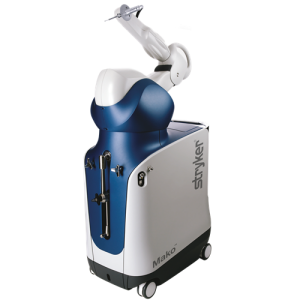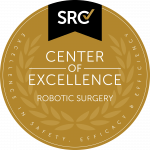Robotic Surgery
A leader in robotic surgery.
Nobody looks forward to surgery, but it may sometimes be your best option for care. If you and your physician feel that surgery is right for you, you can explore the different options for the surgery you need. Traditional open surgery, where a surgeon operates with handheld instruments through a large cut (incision), may be the first method that comes to mind. However, you could also be a candidate for a less invasive approach requiring just a few small cuts, called minimally invasive surgery. Minimally invasive surgery includes laparoscopic surgery and robotic-assisted surgery. Robotic surgery – also called robot-assisted surgery – is a proven technique in which a surgeon uses a computer console to control very small instruments and a high-resolution camera attached to robotic arms. Why robotic surgery? Surgeons who utilize robotics find that for many procedures, they have enhanced precision, flexibility, and control during the operation, and the system allows them to better see the site, compared with traditional techniques. Using robotic surgery, surgeons can perform delicate and complex procedures that may be difficult or impossible with other methods. CLICK HERE TO SEE THE PRECISION ROBOTIC TECHNOLOGY AS A SURGEON PEELS A GRAPE! DaVinci Xi Robotic Surgical System – Surgeon-Led Minimally Invasive Precision Technology
DaVinci Xi Robotic Surgical System – Surgeon-Led Minimally Invasive Precision Technology
Thanks to new robotic technology available at Baylor Scott & White Medical Center – Frisco, many surgical patients no longer worry about lengthy downtimes. Our DAVINCI XI ROBOTIC SURGICAL SYSTEM enables many surgeries to be performed less invasively, typically leading to shorter hospital stays and faster recoveries. Baylor Frisco is proud to have performed the first fully robotic bariatric sleeve in Collin County.
CLICK HERE TO SEE A RECENT ARTICLE ABOUT BAYLOR FRISCO ROBOTICS.
Where innovation meets precision:
Precision Redefined: Robotic surgery offers unparalleled precision and dexterity, translating the surgeon’s hand movements into minute, controlled actions within your body.
Minimally Invasive Approach: Smaller incisions result in less pain, minimal scarring, and a faster recovery compared to traditional open surgery, allowing patients to get back to their daily lives sooner.
Enhanced Visualization: High-definition 3D visualization allows our expert surgeons to navigate complex anatomy with enhanced clarity, improving the overall surgical experience.
Personalized Care: With robotics, our surgeons can tailor procedures to your unique anatomy, optimizing outcomes and reducing the risk of complications.
Wide Range of Procedures: From urological and gynecological surgeries to complex procedures in various specialties, the technology is adaptable and applicable to a diverse array of medical conditions.
Confidence and Expertise: Over 40 of skilled surgeons are trained in utilizing da Vinci technology, ensuring that you’re in the hands of professionals who are proficient with this advanced system.
Robotic surgery with the DaVinci Xi can be utilized for many surgeries, including:
GYNECOLOGIC SURGERY
 Mako® Robotic-Arm Assisted Surgical System
Mako® Robotic-Arm Assisted Surgical System
The MAKO System combines the expertise of our skilled surgeons with the precision and capabilities of robotic technology, offering a range of benefits that can enhance the surgical experience:
Precision: The MAKO System provides our surgeons with a high level of accuracy and control, allowing for precise surgical movements.
Personalized Treatment: Through advanced imaging and 3D modeling, the MAKO System creates a personalized surgical plan tailored to the patient’s unique anatomy, leading to optimized outcomes.
Minimally Invasive: With the assistance of the MAKO robotic arm, procedures can often be performed through smaller incisions, resulting in reduced scarring, less pain, and faster recovery times.
Faster Recovery: Patients often experience quicker healing and can return to their daily activities sooner due to the minimally invasive nature of MAKO-assisted surgery.
Joint-Preserving Solutions: For orthopedic procedures, the MAKO System enables our surgeons to preserve as much healthy tissue as possible, promoting joint longevity.
Wide Range of Procedures: From partial knee and hip replacements to complex orthopedic procedures, the MAKO System can be applied across a variety of specialties.
How it works
The surgeon works from the console within the operating room that uses 3D CT-based planning software so your surgeon can know more about your anatomy to create a personalized joint replacement surgical plan. In the operating room, your surgeon follows your personalized surgical plan while preparing the bone for the implant. This technology allows more precision and a shorter recovery time for total and partial knee replacements.
Find a Doctor
If you are in need of a physician, we can help! Have a look at our directory of doctors & surgeons.
Prepare for a Procedure
View our digital guides so you can confidently navigate your upcoming medical procedure.
Resources for Patients
Access our curated resources designed to empower and assist you throughout your care.
Resources for Visitors
We've curated essential details to enhance your visit and make your time here as informative and stress-free as possible.



FAQs
Robotic surgery, also known as robot-assisted surgery, is a method that allows doctors to perform various medical procedures with a higher degree of precision. Conventional methods rely solely on the skill of the doctor’s hands and vision, whereas robotic surgery uses the power of technology to specify exact measurements and placement. Robot-assisted surgery extends the capabilities of the eyes and hands of a surgeon to provide enhanced precision.
- Input precise measurements
- Guide the robot with minimal invasion
- Less blood
- Less scarring
In a robotic surgery environment, the surgeon will make tiny incisions in the patient where small instruments will be inserted into the patient, along with a high-definition three-dimensional camera. Depending on the type of procedure, the surgeon may not have to cut the patient at all. The surgeon is in the operating room at a console where they control the instruments that he or she uses to perform surgery. The Da Vinci robots at Baylor Frisco provide a 3D high-definition view, giving surgeons a crystal clear view of the surgical area that is magnified 10 times what the human eye sees. The surgeon uses tiny instruments that move like a human hand but with a far greater range of motion.
- Miniscule instruments
- Minimally invasive
- Minimal damage to surrounding tissue
- Less downtime
The instruments and camera can be controlled by the surgeon in a way that minimizes the amount of damage that is done to the tissue during the surgery. As the surgeon performs the procedure, they will be able to control the instruments with extreme precision using a combination of software and hardware that is specifically designed to perform minimally invasive procedures on patients.
No. Several surgical technologies are linked to a computer system that serves to improve the surgeon’s range of motion and vision. A combination of enhanced dexterity and precision is provided with the robotic arm. The surgeon is in total control, using a tiny camera with a 3D definition view and precise instruments for procedures. The robot cannot be programmed and it cannot make any movements on its own
A hysterectomy is a surgery to remove the uterus, and possibly the ovaries and fallopian tubes. Several conditions may prompt your doctor to recommend a hysterectomy. They range from benign (noncancerous) conditions, like endometriosis or fibroids, to cancer conditions, like endometrial or uterine cancer. While the number of women who receive hysterectomies has declined over the last several decades, approximately 400,000 women in the U.S. still receive hysterectomies each year. The length of time it takes for a robotic hysterectomy depends on the type of hysterectomy and the surgeon performing the surgery, but generally, this type of procedure takes 3-4 hours.
Robotic surgery is a viable solution for many different kinds of specialties from gynecology to cardiovascular. Robotics are even used to cut away cancerous cells from sensitive body parts such as nerves and blood vessels. Some of the more popular specialties are:
- Bariatric or Weight Loss Surgery
- General Surgery
- Colorectal Surgery
- Gynecology
- Gynecologic Oncology
- Gastroenterology
- Cardiothoracic Surgery
- Urology
The very fact that a robotic device can be programmed to cut with such precision in minuscule areas that it is ideal for safe and effective procedures that require less invasive techniques and less downtime.
Robotic surgery is a revolutionary method of surgery that can be used in a vast number of surgeries. The technology behind the robotic method was developed so that many common procedures can be done with less invasion, less pain, and less downtime. Some of the surgeries that surgeons can perform with robotics are:
- Bariatric/Weight Loss Surgery
- Hysterectomy
- Gallbladder removal
- Coronary artery bypass
- Mitral valve repair
- Tubal ligation
- Radical cystectomy
- Pyloroplasty
Since the robotic arm and the surgical instruments are so tiny, doctors can successfully complete a serious procedure without adding excessive injury to the patient. As the instruments cut into the patient, the arm is guided by motion that can be programmed to the tiniest and most accurate measurements. This accuracy leaves no room for human error, therefore, cutting down the risk of accidental injury. The end result is a type of surgery that is faster, cleaner, and less invasive than conventional surgery.
Any surgery will most likely be painful in one way or another. However, when it comes to robotic surgery since the instruments are so tiny and the measurements of the cuts are extremely precise there will be less damage than open surgery.
- Smaller surgical instruments
- Smaller incisions
- Precisely measured cuts
- Less damage to tissues
A skilled surgeon will be sure to alleviate pain as much as possible and allow the patient to be as comfortable as they can be. Since robotic surgery is much less invasive and does not require more extensive incisions to accommodate hands or larger instruments, it is generally less painful and has a faster healing time than regular surgery.
Robotic surgery offers many benefits to patients compared to open surgery including:
- Shorter hospitalization
- Reduced pain and discomfort
- Faster recovery time
- Faster return to normal activities
- Smaller incisions, resulting in less risk of infection
- Reduced blood loss and fewer blood transfusions
- Minimal scarring
No. While robot-assisted surgery is an effective option for many people. It is not the appropriate method for every case. Your physician will review your specific procedure along with the risk factors, lifestyle, and conditions that apply to each individual patient.
The experience, training, and volume of a hospital’s program are truly important. Ask your surgeon about his or her level of experience using a robot-assisted method of surgery. It is important to feel confident that you are receiving the highest quality care from an experienced surgeon who is part of an established program. At Baylor Frisco, our experts are at the forefront of minimally invasive robotic surgery. Our surgical leaders are highly specialized and use the latest technologies along with continuous training simulations to perfect their skills.
